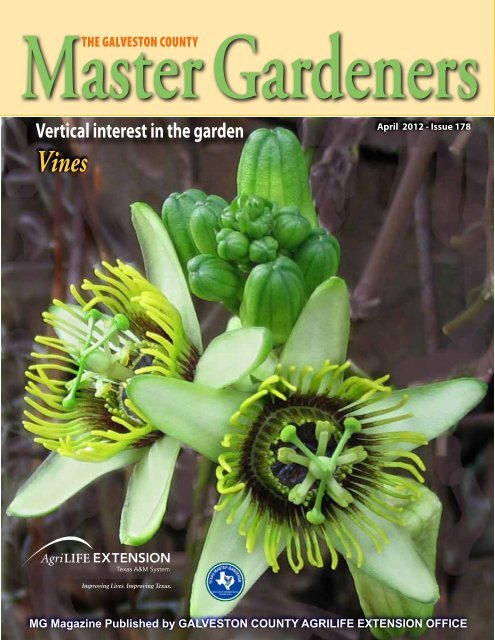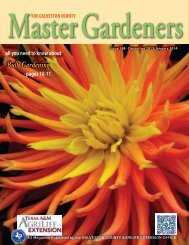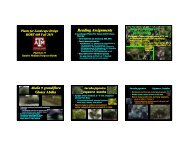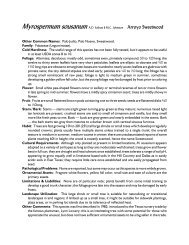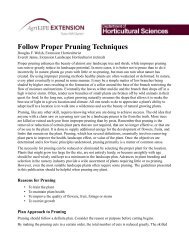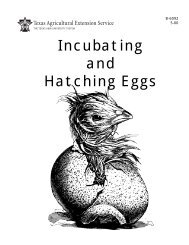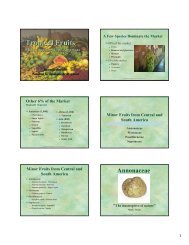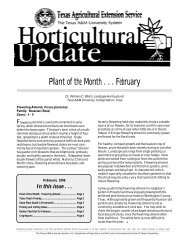Download - Aggie Horticulture - Texas A&M University
Download - Aggie Horticulture - Texas A&M University
Download - Aggie Horticulture - Texas A&M University
You also want an ePaper? Increase the reach of your titles
YUMPU automatically turns print PDFs into web optimized ePapers that Google loves.
Inside This Issue...2 Intro by MG Camille Goodwin3 How to Reach UsHow to Reach Us4 Ask a Master Gardener Q&A: Citrus Greening by Laurel Stine5 Ask a Master Gardener Q&A: Asiatic Hawksbeard by Rachel Montemayor6 Edible Theme Gardening by the Square Foot by Camille Goodwin7 Weeding Advice from the Masters- A MG Survey by A. Lynette Parsons8 Trowels & Tribulations in a Suburban Garden by Donna Ward9 The Island Garden - Is This Your Grandmother's Tomato by Jan Brick10 MG Best Shots & Narrative - Grow with Vertical Vivid Vines by Deane Greer12 Meet a Master Gardener - Dick Carter by Pat Forke13 Meet the GCMGA Board of Directors by Pat Forke13 Junior MG Program at Greta Oppe Elementary by Mary Lou Kelso14 Rose Root Stock Study Project & Rose Bed Monthly Update by John Jons15 Seasonal Bites - Rosemary Shortbread Cookies by Karen Cureton15 Upcoming Events by Karen Cureton16 Project: Demonstration Gardens by Sandra Gervias17 Re-Certification Hours for MGs by Laura Bellmore17 Other Local & State Gardening Events by Yvonne Enos18 Bulletin Board by Karen Cureton19 Fig Ivy Can Be a Mixed Blessing in Landscape by Dr. William M. Johnson20 2012 MGA Monthly Meetings20 Invitation to MG April MeetingExtension Office:Phone. . . . 281-534-3413, ext. 1-2E-Mail. . . . . . . . .galv3@wt.netTo Submit Newsletter Articles:Contact Linda SteberPhone . . . . . . .281-534-6695E-Mail . . .steber8@msn.comTo Submit Monthly Calendar InputContact Karen CuretonPhone . . . . . . . . .281-337-6271E-Mail . . . . klcleela@gmail.comWe encourage your articles!Due the 20th of each month.To Send Volunteer Hours:E-Mail. . . . . .mghours@wt.netSpeakers Bureau:Contact Cindy CroftPhone . . . . . . . . 281-332-7872E-Mailgarden.speakers@gmail.comFront Cover Photoby MG Mona RayCheck out page 11 to get someideas for vines for vertical interestto your gardenExtension programs serve people of all agesregardless of socioeconomic level, race, color, sex,religion, disability, or national origin. The <strong>Texas</strong>A&M <strong>University</strong> System, U.S. Department ofAgriculture, and the County CommissionersCourts of <strong>Texas</strong> cooperating.References to trade names are made with theunderstanding that no discrimination is intendedand no endorsement by <strong>Texas</strong> Agrilife Extensionis implied.
Asiatic HawksbeardBy Rachel MontemayorMG 2012 InternQuestion: Can you identify a weed that has small 1/2 inch lemon-yellow flowerswith multiple petals and with no leaves on a two-foot stem?Asiatic Hawksbeard weed is from theAsteraceae family. It is a non-native herbaceousannual, develops a short tap root, andis erect and slender up to two feet tall. Themultiple branches of the Asiatic Hawksbeardrise from a basal rosette. Floweringstalks usually branch in the uppermost partof the plant. Flowers are smaller than thecommon dandelion. Flowers are about ½inch wide, yellow to orange-yellow withfive tiny teeth at the end of the outermostpetals. More flowering occurs in fall andspring. The leaves may appear similar todandelion leaves, but they are spatulate,long and narrow at the base with a broaderrounded apex. There are few or no leaves onthe stems and the edges are slightly lobed.Asiatic Hawksbeard is predominatelyfound in flower beds, but will also growwell in other sites such as turf grass, pottedplants, cultivated fields, and road sites. It istypically found in non-wetlands in welldrainedsoils but can also be a problem onpoorly drained soils.This weed grows from Pennsylvania toFlorida, Kentucky, Arkansas, and <strong>Texas</strong>. Italso grows in Puerto Rico, Virgin Islands,Hawaii and the West Indies. It is native toJapan and South East Asia. This invasiveweed is now found around the world. It isalso known as Crepis Japonica and JapaneseHawkweed.Asiatic Hawksbeard usually survivesmost winters and blooms year round in ourgrowing area. Reproduction is by seed. Ifyou can pull the weed before it produces aflower and keep it from reproducing, youwill then have a better chance of keepingit in control. You can also keep the yardmowed or use a weed eater or a hoe tokeep the weed from spreading. A properlymaintained landscape that is not stressedby disease, insects, or is not nutritionallyimbalanced will go a long way in keepingweeds at bay.ScientificNameYoungia japonicaFamily: AsteraceaeGroup: DicotSeason: Cool SeasonOtherCommonNamesJapanese hawkweed, Oriental false hawksbeardPhotos by GCMGAThe Galveston County Master Gardeners Magazine - April 2012 - Page 5
salsa garden - edible theme gardening funby the square foot - third in series(Editor's Note: This graphic is republished with permission of The Greer Education Foundation)Who doesn’t lovea great freshsalsa sauce? Asrecently as a generation orso ago, Americans had notheard of salsa. Now, whethersmooth or chunky, salsa onceused only as a dip for chips,has become one of the mostpopular condiments usedto flavor or compliment allkinds of dishes today. You canhave your own fresh salsa in amatter of minutes when youplant a salsa theme garden.The Salsa Garden featuredhere is only one of many waysto incorporate salsa ingredientsinto your square foot plan forfresh salsa whenever you desireit. Exchange any of the plantsto meet your personal taste.When designing your gardenconsider what you like in yoursalsa, do you like it hot, mild,tangy or sweet? If you need aplant that’s not on this designplan, research it to figure outhow many you can plant persquare. Your garden needs tobe in a location that receives 6to 8 hours of sun per day.Salsa gardens have visualappeal with large plants heavywith tomatoes and brightlycolored hot peppers standingtall while cilantro, shallots,garlic and onion nestle intothe soil among them. A salsagarden is a great garden togrow with your kids and grandkids.Gardening Tips:Tomatillos have some similarneeds as tomatoes - theyrequire plenty of space, tonsof sun and the support oftomato cages. Plantingmarigolds around theseplants repels harmful insects.Including flowers amongvegetable beds alsoencourages pollination.Plant List:• 3 tomatillo (transplant)• 18 onion (seed)• 18 cilantro (transplant)• 32 carrot (seed)• 1 bell pepper (transplant)• 1 jalapeño pepper (transplant)• 1 poblano or ancho pepper(transplant)• 12 bush beans (seed)• 2 celery (seed)Bell Pepper• 32 marigolds (transplant)• 3 tomato (transplant)MarigoldsSalsa GardenBy Camille GoodwinMG 2008The The tomatillo tomatillo plant, plant, native native to Mexico, to Mexico, is a type is a type of ground of ground cherry. cherry. It has a It fresh, is has tangy a fresh, flavor tangy that flavor isdelicious that is delicious in homemade in homemade salsas. Cilantro, salsas. peppers, Cilantro, and peppers, onions also and adds onions color, also taste add and color, texture taste to and thispopular dish.texture to this popular dish.CilantroPoblanoor AnchoPepperKey: 1 inch square = 1 footTomatillosOnionsOnions &CarrotsTomatoeson TrellisBush Beans© 2010 Green Education Foundation (GEF) Fostering the new generation of environmental stewards. All Rights ReservedThe Galveston County Master Gardeners Magazine - April 2012 - Page 6
weeding advice from the mastersA survey conducted among galveston county MGsWHAT ARE YOUR FAVORITE TOOLS FOR WEEDING?For some gardeners either bare or gloved hands work best. Someother favorite tools include a dandelion tool, Cobra Head, circlehoe (both long and short handles), a scuffle hoe, a Ken-ho surfaceweeder; long two-pronged fork, short fork, sharpshooter; GardenClaw; 3-pronged rake and, for really tough weeds, a small hatchet.The knives preferred include a kitchen knife, a Japanese gardenknife, and a butcher’s knife. One choice was a flat head screwdriver.Another effective tool can be the two-gallon pump spray bottle withRoundup or Stop Weed.DO YOU PREFER THE CHEMICAL OR ORGANICAPPROACH?Those taking an organic approach offer numerous suggestions.When starting a new bed, be sure to remove all weedy growth fromthe top layer. Be sure to inspect soil, compost, mulch, and plantsthat you add to your beds. Mulch, mulch, then mulch some more.Make lawn care services clean the blades of their tools before enteringyou yard. Non-chemical approaches also include turning overthe beds often. Keep the bed so full of plants that weeds do not havespace to develop. Pull weeds when soil is wet. Use organic sprayswith cinnamon, vinegar, or clove oil. For large areas, use clear plasticto cover weeds thus letting solar energy kill the weeds and pasteurizethe soil. Pour boiling water on cracks in driveway and sidewalk.For a chemical approach, apply Roundup with a q-tip or a paintbrush. Be careful to not use Roundup when there is wind. Someprefer to only use chemicals on poison ivy and poison oak. Thebucket/glyphosate method involves coiling the weed inside a bucket;spraying with glyphosate, removing the bucket and leaving the weedcoated. Another preferred weed killer is Amaze by Green Light.DO YOU HAVE A WEEDING SCHEDULE?The preferred approach is to attack in the spring or at the seedlingstage before seeds are produced and have a chance to spread. Somegardeners weed as they see the weeds developing. You might alsotry setting a weekly time. Or, once the clover shows up, you mightprefer daily. Set certain areas for certain days, such as the front onMonday and Friday, and the back on Tuesday and Thursday. Everycouple of days you might check out your vegetable garden and thenattack your flower beds monthly. Just a few minutes consistentlyeach day should help.DO YOU USE DIFFERENT METHODS FOR SMALL BEDS,GARDENS, LAWNS?Use newspapers around plants and several organic mulch layersin the garden. Limit the soil turning in your garden as it may bringmore weeds to the surface. Be sure to mulch small beds. Roundupcan be used in beds. Under shrubs, paint weeds with undiluted herbicide.Repeated mowing in lawn should help eliminate weeds. Bagthe weedy grass and dispose. Stop Weed or Wipe Out can be used onthe lawn.by A. Lynette ParsonsMG 2011 InternDO YOU HAVE ADVICE ABOUT WHAT NOT TO DO?Do not stress about weeds. They are an on-going challenge. Donot turn the weeds over into the soil; this binds nitrogen while theyrot. Do not plant what you cannot eat. Do not plant invasive plants.Make sure you get the whole root when pulling weeds. Be cautiouswith synthetic chemicals as the residues have a long-term effect onthe natural soil life. Do not neglect the garden. Even if nothing isgrowing right then, mulch or cover to keep the weeds at bay. Mixchemicals carefully. Be sure to read and follow the directions.ANYTHING ELSE?A question was asked: When will they develop a pre-emergent forvegetable gardens? Weeding is the least favorite of garden activities!It is an exercise in patience and perseverance and helps you todecide what is truly undesirable. Amendments, fertilizers, and soilbuilders keep the plants you want strong to compete with the weeds.Dense ground covers help to control weeds. Have the right attitudeand enjoy the beauty when the weeds are gone. God gave us weedsso we would go outside and play, doing what we love…working inthe garden! Weeding is mostly therapy. Listen to the birds, talk toyour neighbors or put on your iPod and enjoy the outdoors! Readthe entire chapter on Dandelions in All I Really Need to Know ILearned in Kindergarten by Robert Fulghum which says that in theend, Mother Nature wins!CONTRIBUTORS: Chris Anastas, John Anderson, Laura Bellmore,Penny Bessire, Martha Bigley, Lilian Canouet, Susan Clasen,Cathy Conlon-Townsend, Mary Demeny, Sandra Devall, LindaGarren, Sandra and Ira Gervais, Jim Gilliam, Barbara Hankins, DorisHeard. Carol Jean Hebert, Clyde Holt, Tim Jahnke, John Jons,Nancy Mitchell, Karen Morris, Frank Resch, Susan Rismiller, EddaScott, Linda Steber, Ken Steblein, Laurel Stine, Wes Thompson,Connia Webb, Anna WygrysDr. J’s advice: "The best thing to put on your garden is yourshadow - good way to keep an eye out for those pesty weeds".Photos by GCMGAThe Galveston County Master Gardeners Magazine - April 2012 - Page 7
THE ISLAND GARDENIs This Your Grandmother's Tomato?(Editor's Note: This is a reprint from Jan's article in "The Islander" magazine.)By Jan BrickMG 2001Spring one day, winter the next! The capricious temperamentof Mother Nature causes angst among gardeners who areplanning their “spring” garden. Upon visiting a local nurseryand purchasing several beautiful healthy vegetable plants for mygarden, my sentiment was “let’s get this done” Plant! Plant! Plant!The following day the temperature dropped to the forties…what isthis? Is it not March? Has not Spring sprung? Apparently not so, Ithought, but fortunately my plants survived not only the drop intemperature, but also the accompanying high winds and torrentialrains as well!Growing tomatoes is probably the most popular gardening activity…notonly among experienced seasoned gardeners but those whodabble with a small plot or a container garden. Most of us have ourfavorite varieties, the ones we plant year after year, again and again.Perhaps it is out of habit, because “my neighbor recommended it”or it was all the nursery had left. Have you ever considered tryingsomething new or something “old” actually…the “Heirloom”tomatoes that have become increasingly popular and more readilyavailable in recent years?According to Greenmarket Heirloom Tomatoes, “The definitionof the use of the word heirloom to describe plants is highly debated.One school of thought places an age or date point on the cultivars.For instance, one school says that the seeds must be over 100 yearsold, others 50 years…another way of defining heirloom cultivarsis to use the definition of the word “heirloom” in its truest sense.Under this interpretation, a true heirloom is a cultivar that has beennurtured, selected, and handed down from one family member toanother for many generations. Additionally, there is another categoryof cultivars that could be classified as “commercial heirlooms,”cultivars that were introduced many generations ago and were ofsuch merit that they have been saved, maintained and handed down- even if the seed company has gone out of business or otherwisedropped the line. Additionally, many old commercial releases haveactually been family heirlooms that a seed company obtained andintroduced.”The main appeal of heirloom tomatoes is their taste… they areeating tomatoes, pure and simple. An interesting aspect of heirloomtomatoes is their color, a rainbow spectrum including stripes andblushes. Each one is different…some are meatier, some have fewerseeds and some taste a bit salty or spicy. These types of tomatoes canbe found in a variety of colors, shapes, flavors and sizes.Other intriguing tomatoes of the heirloom varieties consist of additionalblack or purple selections like the Purple Cherokee tomatoesthat are beefsteak in style, with green “shoulders” across the top.This variety is over 100 years old and was originally grown by theCherokee Indians. It has a rich flavor and is considered one of thebest of the heirlooms. Another black/purple choice may be the BlacRussian. These black tomatoes have a rich flavor and turn to darkreddish black when mature. The Blac Russian is one of the best ofthe black varieties on the market.If you favor lighter colors in your tomato collection, select theOxacan Jewel: A bicolor tomato that ripens to a golden yellow, withstreaks of red and orange. The flavor is rich and fruity, with a hint ofmelon. The Hillibilly is an heirloom variety that comes to us fromWest Virginia. It has an orange color with dark red streaking. Thefruit is sweet and fruity with a high sugar content.Surely, with as many varieties as this from which to select a new“old favorite” for our tomato beds, we will find ourselves exchangingthe exotic-looking and tasting fruits with our neighbors and friendsin the soon-to-be harvest!Strolling through your garden…picking a sample tomato…eatingit on the spot …what bliss!Some recommended varieties are listed in thepublication, “Common Sense Vegetable Gardening forthe South” by William D. Adams and Thomas LeRoy.Among those suggested are:Calabash: Purple color, flavor is sweet, medium tolarge fruit, vigorous and productiveCostoluto Genovese: Red color, flavorful Italianadapted to hot weather, strong-growingEva Purple Ball: From the Black Forest Region of Germany,mid-size, great flavorGarden Peach: Yellow/pink, fuzzy skin, mild flavorGreen Grape: Green in color, quarter-size fruit, sweetand juicy, compact plantGreen Zebra: Striped with yellow and green, gourmetquality, small to medium fruitPersimmon: Rose/orange in color, large fruit, high ratingin taste testsWhite Wonder: White in color, medium sized fruitThe Galveston County Master Gardeners Magazine - April 2012 - Page 9
MG BEST SHOTSCoral Vine by Judithe SavelyPassionflower by Mona RayBougainvillea by Helle BrownConfederate Star Jasmine by Margie JenkeCarolina Jasmine by Herman AuerRangoon Creeper by Linda SteberThe Galveston County Master Gardeners Magazine - April 2012 - Page 10
…and Narrativegrow with vertical vivid vinesNeed to add some vertical interestto your otherwise horizontallandscape? Need to cover thatboring gray, brown or chain length fence?Need to provide a windbreak and wantsomething fast growing and relatively pestfree? Have an arbor, patio roof, gazebo, orstone wall that needs covering? Want to addsome pizzazz with brilliant color but don’thave much lateral land space to spare? Well,blooming vines provide the answer. A sunnyexposure, soil amended with a bit of compost,peat moss, or other organic material,and a trellis, fence, post, or wall for supportare all that’s needed to provide beautifulblooming vines. The following vines areproven winners for Southeast <strong>Texas</strong> and theGulf Coastal areas.Coral Vine (Queen’s Wreath) Aligononleptopus - Native to Mexico this perennialtropical evergreen vine will grow in partialsun, is fast growing and will reach 35 to 40feet if happy. It isn’t picky about soil butdoes require good drainage. Its lacy pink,dark rose pink, or white clusters of bloomsare very showy and appear summer throughfall. Since it climbs with tendrils, it needssupport from a trellis, fence, or tree andmakes a good cover for a patio and a greatwind break. While drought tolerant, itputs on its best show after first rains of latesummer. A hard freeze will decimate the topfoliage; however, it rebounds from the roots.Propagation is thru division or seeds.Passionflower Passiflora x alatoeacrulen -Native to Brazil this vine gets its name fromsymbolism associated with the Crucifixion.It requires full sun to partial shade in the afternoonon hot summer days. A fast growerthat can reach 10 to 20 feet, its tendrilsrequire a trellis or some other support, and itis good for trellises and over fences and walls.While it grows in average soil, it does requiregood drainage and regular watering is neededto keep it in bloom. It is often grown for itsunusual violet-blue multi-petalled flowers.The vine will die back in the winter but willreturn from the shallow roots if they havebeen well mulched. Harvest the seeds forpropagation.Bougainvillea Bougainvillea spectabelis- Native to Brazil this tropical woodyevergreen vine with spines grows in sun tobright light, can reach fifteen to eighteenfeet in height, and needs a trellis, fence orsome type support. A fast grower, its smallwhite tubular flowers surrounded by threelarge paper-like bracts bloom best on eighteento twenty inch branches and providea spectacular display of color year roundwith a mild winter. Since it blooms on newgrowth, pruning is required. Regular applicationsduring the growing season of a halfstrength balanced water soluble fertilizer orhibiscus food will increase blooms. Waterthis drought tolerant vine sparingly becauseit blooms best when under stress and rootbound. Propagation is thru cuttings.Confederate (Star) Jasmine Tracheaelospermunjasminoides - Native to China thispopular evergreen vine produces fragrantbright white small pinwheel shaped flowersspring thru summer. It requires sun to partsun, well draining soil, and regular pruningfor thicker plants and to keep this vigorousvine in check. This vine is a “twiner” andgreat for covering fences, arbors, patio roofsor as an eighteen inch ground cover. Manyhomeowners grow it near their residencebecause of the fragrant flowers it produces.It is drought tolerant and can be propagatedthru tip cuttings.Carolina Jasmine Gelsemium sempervirens- Native to Tropical America this perennialevergreen vine can reach ten to twenty-fivefeet. It is prized for its lanceolate, deepglossy green foliage and its showy display ofbright yellow singular tubular flowers grownin clusters which appear in early spring. Itgrows in sun, part sun, or shade in acidic oralkaline soil. It is most happy in moist soilbut does not like to be over watered. Sinceit climbs via twines, it is great on fences,patio covers, and rock walls. Some gardenersalso use it as a mounding ground cover.Propagate thru seeds, stem cuttings, or airlayering.Rangoon Creeper Quisqualis indica - Nativeto Burma, New Guinea, and the PhilippineIslands this tropical perennial vineBy Deane GreerMG 2009grows in sun to part sun and is a vigorousgrowing, free branching vine which needssupport. With a length range from six tothirty feet it is a good climber over fences,trellises, patio covers, arbors, etc. Thisornamental vine prefers soil amended withfertile humus and some sand and requiresmoderate but regular watering until established.Once established it is fairly droughttolerant. Foliage is generally lush and green;however, the blooms steal the show fromsummer thru fall. The beautifully coloredflower clusters with pendulous trumpetshapedblooms open white, then turn pinkand end deep pink, bright red or reddishpurple over a three day period. Foliage willdie back if subjected to a low of thirty degrees,but the vine will grow back from theroots. Regular pruning will increase bloomssince it blooms on new wood. Propagatethru seeds, cuttings, or layering.Other flowering vines which performwell in Zones 8/9 include Sweet AutumnClematis Clematis temiflora, Black-Eyed SusanThunbergia alata, Mandevilla Mandevillasplendens, Hyacinth Bean Vine Dolichoslablab, and Trumpet Vine Campsis radieans.All of the vines discussed above may also begrown in containers and as a ground cover.In addition, their trailing, branching habitmakes them good candidates for hangingbaskets. While all vines, especially floweringvines, require some pruning to keep themin check and a bit of care, the rewards areworth the “blooming” effort.Mandevilla by Margie JenkeThe Galveston County Master Gardeners Magazine - April 2012 - Page 11
meet the gcmga board of directors by Pat ForkeIf you are interested in an overview of what is happening within our Galveston County Master Gardeners Association, you mightconsider attending the quarterly meetings of the Board of Directors. The Board of Directors meetings are held the first Wednesday ofMarch, June, September and December at 4 p.m. at the Extension Office. Anyone may attend and anyone may request to be put on theagenda through Laura. We are very fortunate to have within our organization volunteers who make decisions as to the direction we take to beconsistently improving and supporting our goals. We have five elected board of director members, a president and numerous vice-presidentsand committee chairpersons that, along with Dr. Johnson, comprise the leadership of our organization.The Galveston County Master Gardener Association is an incorporated voluntary, non-profit, educational, literary and charitable organization.Our goals are to support local Master Gardener volunteers in Galveston County and surrounding areas, to provide a centralized base forinformation exchange among the members of the Corporation, and to organize and support the distribution of horticultural information andassistance provided to the general public.The Board of Directors consists of five members elected for three-year staggeredterms. Our current Board of Directors consists of John Jons (Chair),Frank Resch, Ken Steblein, Camille Goodwin (Secretary) and our newest member,Dick Carter. The purpose of our Board of Directors is to advise and guidethe organization through the elected officers. The Board is also responsible forthe annual audit of financial records. The current elected officers consist of JimEdwards, President; Herman Auer and Yvonne Enos, Vice-Presidents of EducationalPrograms, Clyde Holt, Vice-President of Raised Beds; Julie Cartmill,Vice-President of The Orchards; Ira Gervais, Vice-President of Media, and WesRuzek, Treasurer. Dr. Johnson serves as Master Gardener Program Coordinator.Consider attending one of the meetings to find out what is happening in ourPictured left to right: Ken Steblein, Frank Resch, John Jons,and Dick Carter. Not pictured is Camille Goodwin.organization or perhaps volunteer to serve in some capacity and help guide ourorganization.New Junior MG Program at Greta Oppe Elementary School in GalvestonMary Lou Kelso MG 2000 and Katie Pistone Blaser, a Science Specialist teacher, established a Junior Master Gardener Program inAugust 2011 at Greta Oppe Elementary in Galveston. Mary Lou retired from Oppe in 2001 after working there as librarian forover 10 years. Approximately 60 third and fourth grade students participate in the program.This was not the first initiative to start a gardening program at Oppe. In 2006 after attending a workshop, veteran kindergarten teacherKaren Heuman wanted to establish an outdoor classroom for all grades. Fundraising was not an easy task—it took two years of writing grants,sending letters and contacting organizations to raise the money necessary to build the garden. While a multitude of box stores, civic organizations,and Galveston benefactors listened, they made no donations so the Oppe PTO and generous friends and parents came together to raisethe money required for the garden area to be constructed. It was dedicated May 22, 2008 which coincided with the School’s 20 th Anniversary.A few months later, Ike struck and the garden was destroyed--all of the landscape timbers were found on 81 st Street. They floated over thefour foot chain linked fence. After several months, the garden area once again had raised beds in place and last year a Galveston Garden clubmember helped the children and teachers get the beds underway. Unfortunately over thesummer the irrigation system failed resulting in the beds suffering again.Over the years, Mary Lou has kept in touch with her Oppe friends and Karen asked herto come on board with a more structured garden program. Then in March 2011 MaryLou and Katie connected and decided to launch Oppe Elementary Junior Master GardenerCertified Program in the fall.Since August, Mary Lou and Katie meet twice a month with their students on thesecond and fourth Thursdays of the month after school. They start their program with aclassroom session and then go out in the garden to work. In October they held a Saturdaymorning Garden Day and parents and children of all grade levels came and worked in thegarden and contributed bedding plants, mulch, and perennials. On Saturday, March 31they are hosting another Garden Day from 9AM to 12PM with MG Herman Auer speakingon Gardening 101. MG Ken Steblein and Herman Auer have been speakers during theyear and Herman has worked with the students, Mary Lou and Katie in the garden.The Galveston County Master Gardeners Magazine - April 2012 - Page 13
y John JonsMG 2003Galveston Master GardenerGardens: Rose Root StockStudy Project – 2011 End ofYear UpdateSt. PatrickVeterans HonorStudy Objectives 1: The intent of this study was to compare two hybrid tea rose varieties grafted on to two different root stocks todetermine which root stock produced (a) the most growth and (b) the highest number of blooms. The rationale for the study is thatrose growers, primarily north of Galveston County, claim that the Fortuniana roots stock produces more robust growth and more floriferousroses, than roses grafted onto other root stocks. The rose varieties selected were St. Patrick (yellow) and Veteran’s Honor (red) graftedonto both Dr. Huey and Fortuniana root stock. The roses were planted in March of 2012. These roses were regularly dead-headed to increasebloom production.Update: The table below lists the data for the first nine months of rose growth. With the exception of rose #1 – Veteran’s Honor on Dr.Huey root stock, there is not much difference in the growth between the two root stocks. The Veteran’s Honor on Fortuning may have endedup having the same growth size as the variety on Dr. Huey, but several large canes were broken-off the bush, as a result of wind damage. Youwould expect a difference in bloom product between the two roseTotalVariety Root Stock Booms1) Veteran's Honor Dr. Huey 135.02) Veteran's Honor Fortuniana 157.03) St. Patrick4) St. PatrickDr. HueyFortuniana236.0220.0Planted 12/28/11Size SizeHeight 15 72 57Width 15 60 45Height 25 53 28Width 17 53 36Height 20 48 28Width 18 51 33Height 24 60 36Width 10 42 32GrowthInchesvarieties as indicated but there appears to be minimal difference inbloom production between the two different root stocks. Some ofthe rose blooms on Veteran’s Honor, on both root stocks, exceededsix inches in diameter. A difference in the impact of the roots stockmay be noticed as the roses mature.Other: As the study roses are “hybrid teas” – which are the kindof roses you buy in a flower shop and are rumored to be difficult togrow - a high maintenance program of fertilization, fungicide andinsecticide treatment was planned for these study roses. The roseswere initially treated with the ‘cides shortly after being planted,primarily to clean the roses and prevent chilli thrips. As the rosesappeared to be growing very healthy in April, the maintenanceprogram was modified to a low or no maintenance program; to onlytreat with ‘cides if a “significant” problem occurred. For the rest of 2012 the roses were not treated with any ‘cides. Some minor black-spotwas noticed in late December. Minimal to no insect damage was noted on the roses. This illustrates that if you select the right varieties of roses(grow good locally and proven to be disease resistant) and you provide the optimal cultural conditions (full sun, lots of air movement, gooddrained soil and water) most roses can exist with minimal or no care.Study Objective 2: To determine (a) how successful an application of a pre-emergent herbicide on a rose bed would be in preventing weedsand (b) if it would have any impact on the roses. In March of 2012, half the rose bed was treated with a pre-emergent herbicide per the instructionson herbicide’s label and half the rose bed was untreated.Update: The study was discontinued in July of 2012 as many different types of weeds grew aggressively all over the bed, in both the treatedand untreated areas.Summary: The herbicide application did not appear to work. The reason it did not work may have been because there was a large amount ofweed seeds in the mulch, or in the existing soil and/or the soil used in the construction of the rose bed, and/or due to the constant high levelof air movement (wind) in the GMG gardens area that may have been constantly blowing new aggressive weed seeds onto the bed. Since July,a routine of regular hand-weeding and mulch replenishment on the bed has proven to be very successful in reducing the weed impact on therose beds.Throughout the year I get questions on “what should I be doing to my roses, now?” So, to help answer these questions, I havedrafted a bunch of monthly articles for our newsletter that will highlight what you should be doing to your roses during the comingmonth.By April your roses should be flush with new growth. We no longer have to worry about frost (south of I-10). The cool spring weather tendsto produce both numerous very large rose blooms. Typically, this is the best time of the year for rose blooms. Except, for last year where thecool fall and early winter produced the best growth of the year. Here is a list of things you should be doing in April.Fungicide and Insecticide Spray Program: If you have problems, use a curative product. If you do not have problems, use a preventativeproduct. For the last two years, roses (and other ornamental plants) have been plagued by chili-thrips that destroy new foliage. If not controlled,this damage may significantly impact the bush all summer long. The damage is often mistaken for herbicide damage – crinkled anddeformed new growth. If you see any signs of these nasty little guys, you may want to consider using the appropriate insecticide to thwart theirattempt to devastate your roses (and/or other plants). I always suggest that you only spray for insects if it’s a problem that you cannot tolerate.Fertilizing: Use a good granular fertilizer. Also consider using organics they are slow acting but effective. Water after fertilizing. You canfertilize roses with a granular every month and a good quality rose will reward you with growth and blooms, but be careful not to over-fertilize.Water: Now is the time to figure out how much water you need to provide to your roses to produce the bloom growth you desire and establisha watering program to meet the roses and your needs. In theory, the average rose needs about 2” of water per week. You can help conservewater by having a mulch 3-4” deep.The Galveston County Master Gardeners Magazine - April 2012 - Page 14
Project: Demonstration GardensCarbide ParkWith such a mild winter, work at the Demonstration Gardens at Carbide Park slowed onlyslightly. Mid-February saw another workshop from Sam Scarcella, this time on plantingtomatoes and peppers. Valentine’s Day is his reminder date for planting them and he gavea hands-on demonstration of his methods. He also showed gardeners how to make mini greenhousesfor the tender plants, using tomato cages and disposable plastic barrel liners. These protect young plantsfrom late frost and strong wind and keep the temperature inside the mini tents elevated, promoting fastergrowth.The warmer weather and spring rains have many plants budding and blooming earlier than normal.Garlic planted in the November workshop is happy and robust. The pink and white blooms on the variousfruit trees in the orchard put on a show to almost rival the “Cherry Blossom Festival” in Washington,D.C. Hopefully this year they will produce a bumper crop of stone fruit that will make Julie Cartmill’swatering, pruning, spraying and fertilizing worthwhile. But this is spring in <strong>Texas</strong>, so nothing is certain.March saw John Jons give a hands-on workshop on pruning roses. Besides showing gardeners how toproperly prune them, it also resulted in needed haircuts for the regular roses and shaping for Don Juanand the other climbers around the gazebo. Across the fence on private property, the blooms of the wildMacartney rose were putting on a seductive spring show. Though lovely in spring, farmers, cattlemenand gardeners rightly treat this rose with contempt; it is invasive, easily spread and almost impossible tocontrol or eradicate.The Elbon grass experiment continues. Elbon was planted to manage root-knot nematodes by trappingthem in the plant itself. After cutting the grass and disposing of it to avoid reinfection of the area,the beds were tilled for crops to be planted. If these crops are free of nematodes, the Elbon grass will haveproved its usefulness in the fight against nematodes. Only time will tell.Work on other projects for Carbide Park continues. The pole barn is about to get its roof. Electricityis on its way to the Master Gardeners building and hopefully will be turned on soon. A walkway to theAsian Garden is being installed. Wayne Elliott built simple but decorative trellises for the grapevines thatPeggy Budny tends. Her various muscadine and Mortenson grapes will have room to spread out and produce.Everyone is busy putting in plants and seeds for the usual favorites: tomato varieties from Celebrityand Big Boy to various heirlooms, peppers of all types and strengths, and beans both bush and pole. Let’shope the <strong>Texas</strong> weather smiles on these hopeful signs of spring.The entrance to the Asian Garden is being reworked to reflect a more minimalist theme. The grass willbe removed and mulch and pea gravel will surround the new entrance walkway to the garden’s interior.A few additional plants will be added to replace those that didn’t make it through the winter. Carine hasexpertly trimmed most of the bamboo specimens to better show the beautiful canes of the various speciesand Tish has restyled the grass plants with recent spring haircuts. Tish has also updated her front entrygarden near the arbor with fresh spring color. The Asian Garden Team, along with one of our favoritegarden guys, Joe Fisher, recently rescued a heirloom “Old Blush” rose bush from another garden at thePark that was being repurposed. The rose looks great near the garden’s chimes. We really appreciate Joe’sassistance moving this large rose. The team is also pleased to note that Alisa Rasmussen has joined theAsian Garden team; her passion, enthusiasm and spirit has provided immeasurable assistance to the teamand we’re thrilled to have her. The team has decided they will also maintain the trees in the north endof the garden. We could use help with spring weeding and mulching at the base of the trees. If you havesome time and can assist, please come on any Thursday. If you haven’t visited the Asian Garden recentlycome see it!Spring is ComingBy Sandra GerviasMG Intern 2011Photos by Ira Gervias, Julie Cartmill & Tom FountainEarly Blooms in the OrchardPeach BlossomGrapevine TrellisesRaising the RoofAsian GardenThe Galveston County Master Gardeners Magazine - April 2012 - Page 16
e-certification (continuing education) hours for MGs 2012Re-certification (Continuing Education) Hours for MGs 2012Date Event Speaker Topic Cont Educ Hrs1/07 Saturday Seminar Jerry Hurlbert Growing Avocados & Papaya 31/07 Saturday Seminar Herman Auer Successfully Growing Peaches in GC 2.51/14 Saturday Seminar Sam Scarcella Grow Great Tomatoes 2.51/14 Saturday Seminar Jenifer Leonpacher How to Grow Tomatoes w/ an Aeroponic System 11/14 Saturday Seminar Gene Speller Peppers from the Sweetest to the Hottest 21/21 Saturday Seminar Luke Stripling Successful Spring Vegetable Gardening 2.51/21 Saturday Seminar Herman Auer Growing Citrus in the Home Landscape 21/28 Saturday Seminar Heidi Sheesley Fruit & Citrus Trees for the Gulf Coast 21/28 Saturday Seminar Herman Auer How to Plant Your New Trees 11/28 Saturday Seminar Dr. David Cohen Growing Blueberries 22/10 Pilot Program Karen Lehr Plan Before You Plant 2.52/11 Saturday Seminar John Jons Gardening by the Square Foot 22/11 Saturday Seminar Mary Demeny Kitchen Gardening 22/25 Saturday Seminar John Jons Anyone Can Grow Roses 23/03 Saturday Seminar Sam Scarcella Tomato Stress Management 231Last updated: March 19, 2012other local & state gardening eventsPlease see our complete list that appears on each E-Dirt edition.Gardeners by the Bay Garden Club will be holding their annual plant Sale on April 4, 9:00 am - 12:30 pm this year. It willbe located at the <strong>University</strong> Baptist Church in Clear Lake http://gbtb.org/Arborgate Nursery showcases the best in perennials, herbs, roses and native plants. Lots of awesome programs in Aprilwith more good ones in May. If I only had the thyme to drive out there and see the wise sage with his skullcap, parlaying hisparsley for parsnips! http://www.arborgate.com/classes.phpinby Yvonne EnosMG 2008If you feel like a trip to Austin, the Heart O’ <strong>Texas</strong> Orchid Society is having their 41 st annual orchid show and sale at the Zilker BotanicalGardens/Austin area garden center on April 28 thru the 29. See http://www.hotos.org./ for more information.Mercer Arboretum’s annual Garden Party and Auction, will be held on Saturday, May 5, 2012 beginning at 5 pm. At this event, party-goersdine under the stars while bidding on unique and extraordinary treasures. A silent auction with a wine and beer reception kicks off the evening,followed by dinner and a live auction. Proceeds benefit special garden projects and programs at Mercer. For more information see http://www.hcp4.net/mercer/programs/index.htmBonsai is a rewarding and fulfilling pursuit that can provide many years of artistic expression, a sense of accomplishment and satisfaction,camaraderie with other practitioners, and can teach patience, love of nature, and calmness of mind The Houston Bonsai Society meetsregularly in the Houston Garden Center. Their State Convention will be held in Dallas, <strong>Texas</strong> on April 27 - 29. If any of you are interested seehttp://www.houstonbonsai.com/Houston Cactus and Succulent Society is a group of people interested in the study, cultivation, conservation, and just plain enjoyment ofdesert plants. Their spring sale will be May 12 and 13 at the Houston Arboretum. http://www.hcsstex.org/International Oleander Society will have its Spring Oleander Festival, April 27, 28 & 29 held at Moody Gardens Visitor Center. Moredetails to come… Check out their site http://www.oleander.orgThe SFA Gardens at Stephen F. Austin State <strong>University</strong> will host its annual Garden Gala Day from 9 am until 2 pm, Saturday, April 21,2012 at the Pineywoods Native Plant Center, 2900 Raguet St. , their Native plant conference on May 18 and 19, and finally, the Theresa andLes Reeves Lecture series continue throughout the months at 6:30 pm. For more information visit http://www.sfagardens.sfasu.edu/Houston Hemerocallis & Houston Area Daylily Society Flower show is on May 12, 2012 at the Gethsemane Lutheran Church, 4040 WatongaHouston, <strong>Texas</strong>. http://www.ahsregion6.org/calendar.htmPlumeria Show and Sale will be on Saturday June 9, 2012, 5002 Nasa Rd 1, Seabrook (Clear Lake), <strong>Texas</strong> at the Bay Area CommunityCenter. Hundreds of registered Plumeria cultivars, as well as rare plants, will be for sale. Expert growers will answer questions, and there will bea gorgeous bloom display of all the flowers being sold. ARRIVE EARLY for the best selection. Hours are 9:30 am til 3:00 pm for more info,see http://www.theplumeriasociety.org/The Galveston County Master Gardeners Magazine - April 2012 - Page 17
ulletin boardVolunteer OpportunitiesPhone Lines: Master Gardeners are always needed to answerthe public’s questions. This is done at the Extension Office andtime slots are available for every day of the week. Contact LauraBellmore at or 281-534-3413, ext 1-2, or LaurelStine, ext 1-6 or . See your last e-Dirt newsletterfor more details regarding volunteer opportunities.Program VPs Yvonne Enos and Herman Auer are asking for volunteersto host backyard meetings. You may contact Yvonne atVJEnos@comcast.net or Herman Auer at hauersrmga@comcast.net. Please volunteer.image seekersImage Seekers meets on the second Wednesday of eachmonth at 1:30 pm at the Extension Office at Carbide Park.This photography group is open to all Master Gardenersand Master Naturalists for fun, learning and practice ofphotography. Pictures are submitted to the MG/MN databasefor use in publications and lectures.upcoming conferences<strong>Texas</strong> State Master Gardener Conference will be held May 3-5,2012 in San Antonio, TX. It is being hosted by the Bexar CountyMaster Gardeners and <strong>Texas</strong> AgriLife Extension. Seminars willtake place at the Norris Convention Center at IH-10 and Loop410. There will be a welcome dinner on Thursday night, May3, 2012. Tours will be on May 5, 2012 and include but are notlimited to garden centers, a Farmers Market, Sandy Oaks OliveOrchard, Botanical Gardens, Mitchell Lake Audubon Center, andthe Rose Emporium and Gardenville. Please see Bexar CountyMaster Gardener website www. bexarcountymastergardeners.org for more details on the programs, registration, and hotelinformation.The International Master Gardener Conference will be heldSeptember 7-14 on board a Holland America Cruise Ship. Itwill depart from Seattle and sail to places like Glacier Bay, Sitka,Ketchikan, and Vancouver. It will return to Seattle on the 14thof September. See the <strong>Texas</strong> Master Gardener Website underfuture events for information on this.garden team scheduleThe gardens around the Extension Office are maintained underthe team leadership of Peggy Budny who may be contactedat 281-334-7997 or e-mail her at .Come out and have a good time while learning more aboutornamentals. Peggy's team meets the 2nd and 4th Thursday ofevery month at 9:00 a.m.Volunteer at the Demonstration and Research Garden atCarbide Park at 4102 Main St., La Marque. This can involveplanning, planting, weeding, construction, and orchardupkeep. Contacts are James C. Edwards ,Clyde Holt (vegetable beds) andJulie Cartmill (orchards) . The WorkTeams meet every Thursday morning. Go out and lend a hand.specialist & other MG RelatedtrainingPlease see the <strong>Texas</strong> Master Gardeners Website for details.http://www.texasmastergardeners.com. You may downloadthe application forms from that website. Note that allapplications for the Specialist Training courses must beapproved by Dr. William Johnson. Note that fees do not includelodging.MG Specialist-Irrigation Efficiency Training. Dates to be held:March 26, 2012 - March 28, 2012. Place: San Antonio BotanicalGardens. 555 Funston Place, San Antonio, TX 78209. Cost is$200.00. Ph# 210-467-6575. Forms may be downloaded fromthe TMGA websiteMG Specialist-Citriculture Training. This has become a hottopic because of Citrus Greening Disease (CG). This will bea comprehensive educational program aimed at preparingMaster Gardeners to grow citrus in the home orchardsuccessfully and manage the challenging complex ofassociated insects and diseases, including CG. Dates to be heldApril 12, 2012 - April 13, 2012. Place: Montgomery CountyExtension Center at 9020 Airport Road in Conroe, TX. Phone#936-539-7824. Registration Fee is $100.00. Participants mustbe pre-registered by their County MG Coordinator/Agent(Dr. William Johnson in our case) and approved by the MGSpecialist Training Coordinator (Monte Nesbitt, ExtensionProgram Specialist). Form and required authorizations may beobtained by contacting Dr. Johnson.MG Specialist-Plant Propagation Training. Date: May 18,2012 - May 19, 2012 at the Montgomery County ExtensionCenter at 9020 Airport Road in Conroe, TX. Ph# 936-539-7824.Registration fee is $180.00. Form may be downloaded from theTMGA website under Specialist Training.MG Specialist-Composter Training. Class III. Date: June 13, 2012-June 15, 2012. Place: San Antonio Botanical Gardens at 555Funston Place in San Antonio, TX 78209. Ph# 210-467-6575. Feeis $225.00. Form may be downloaded from the TMGA website.EARTH-KIND TRAINING FOR MASTER GARDENERS — <strong>Texas</strong>Master Gardeners may select on-line modules to obtain upto 3 hours of re-certification education credits in a calendaryear. Each module is worth 1 hour of credit. Master Gardenersare not encouraged to seek re-certification credit for trainingmodules they have completed in previous years.LANDSCAPE DESIGN STUDY COURSES — These coursesprovide an opportunity for more in-depth training inlandscape design than is normally included in the MasterGardener curriculum. Each course is typically approved by localMaster Gardener chapters to qualify for 12 hours of continuingeducation toward maintaining certification for MasterGardeners.MGTV-TEXAS — The goal of MGTV <strong>Texas</strong> is to train MGvolunteers in the use of these tools to assist in supportingCounty, Regional and State Extension educational programs.As the number of trained volunteers increases, we will soonhave a network of web communicators, sharing informationon key programs and activities throughout <strong>Texas</strong> and beyond.CENTRA — To see a listing of public events available for videoplayback on AgriLife Extension’s Centra Symposium, on theCentra page select “Public Events” (top left) and in the searchbox type “Master Gardener”.The Galveston County Master Gardeners Magazine - April 2012 - Page 18
the last word . . .FIG IVY CAN BE A MIXED BLESSING IN LANDSCAPE(Editor's Note: This article is a reprint of Dr. Johnson's Weekly Gardening Column inThe Galveston County Daily News)Photo by GCMGAOne of the more intriguing inquires made at our informationbooth at the recent Galveston Home and GardenShow regarded the identification of a vine with numerousbut rather strange clusters of fruits.The vine in question is commonly known as fig ivy but I refer to it asthe Vine from Hades. I have amassed quite a lot of knowledge aboutthis vine. Unfortunately, for me, my knowledge was gained the hardroute, i.e., through exasperating experiences.Many years back, my neighbor brought a small container of fig ivyfrom a local nursery. It was growing on a wooden stake and presenteda rather attractive set of contrasting dark and light green leaves.I knew it to be fig ivy but was not prepared for the battle I wouldbecome engaged in trying to keep the vine from trespassing onto myproperty line. First, the vine took over the wood fence and becametop heavy as the vine’s growth soon reached the top of the fence.Apparently, fig ivy does not understand nor respect property rightsas it managed to nose dive below ground only to send up stemsalong my home’s foundation and brick wall a few feet away from thewood fence.The fig ivy managed to grow up to the top of the chimney. Thestraw that broke the camel’s back came when fig ivy vines reachedthe Hardie plank siding. I had just painted the siding and the figivy was positioning itself to undo all the paint work since each stemproduces a maze of roots that spell trouble for paint jobs if you try toremove the growth.So, it was finally time for the fig ivy to go, but I was to soon findout the fig ivy was not going down without a fight. I pulled and cutvines back to remove them from the brick wall and the fig ivy wouldsprout out a flurry of new growth to replace the growth I took away.Now, you have to understand my neighbor thinks the vine is cutegrowing on the fence. I grudgingly admit the fig ivy was attractiveand added texture — when it stayed on the fence.My neighbor soon adopted my battle-hardened attitude againstthe fig ivy when the rascally vine decided to take another undergroundroute eastward toward her house and promptly started scalingthe brick wall of her home. Sadly, fig ivy will start to grow onto aroof, which definitely would lead to moisture penetration problems.So, when neighbors can agree on the eradication of pesky vine, thebattle becomes easier and less clandestine. It took a while, but I’mhappy to report our properties are now fig ivy free.So, it should not be surprising that I empathized with the frustrationin dealing with fig ivy. One inquirer stated that his fig ivy hadmanaged to climb up nearly to the top of his very tall pecan.Because the growth of fig ivy was so dense, the pecan tree hadstarted to decline. In fact, a 10-inch diameter limb had died backbecause of excessive growth from fig ivy and subsequently broke off.Fortunately, no damage to the nearby garage was incurred but itsignaled that walking through the backyard soon could become ahigh stakes, life-threatening activity.How does fig ivy become established in home landscapes? In mostinstances, the property owner actually voluntarily brings it in afterpurchasing it from a nursery.The Galveston County Master Gardeners Magazine - April 2012 - Page 19By Dr. William M. JohnsonCEA-HORT & MGProgram CoordinatorFig ivy is considered invasive and veryaggressive by some authorities, while others point to its positive attributesof being low maintenance — if you ignore the time neededto keep it within set boundaries.How common is it for fig ivy to produce figs? The lemon-sizedfruits are not often seen because the vine is — or should be — frequentlypruned to contain the aggressive growth.However, mature, horizontal-growing stems might producepale-green 3-inch long fruit. Fig ivy — botanical name: ficus pumila(repens) — is related to edible figs (Ficus cariaca).Some reports state fig ivy fruits are edible, while some report it tobe inedible. Given these contradictions, I am not about to personallyfind out which is correct. After all, it would be shameful to endup in an emergency room and have to explain I ate the fruit of theVine from Hades on which I had issued multiple declarations ofwar.Is fig ivy parasitic? No, as fig ivy does not derive any nourishmentfrom the tree — or a brick wall — but its rampant growth cancreate an unhealthy situation for a tree. If fig ivy becomes well-establishedon the trunk of a tree, its leaves and vines can spread into thetree’s canopy.This can prevent adequate sunlight from reaching the leaves ofa tree in addition to reducing air movement within the canopy ofthe tree. There also is the added risk to the tree being blown overby high winds because of increased wind resistance. Strugglingtrees might produce so little new growth that the ivy shades out theremaining part of the canopy.Residents are probably more familiar than they suspect with thisplant. It is frequently used to give distinctive appeal to topiaries inhome landscapes as well as commercial landscapes. It can be seenalong highways growing up concrete walls.If you want a plant that’s tough, is evergreen and can take a lickingand keep on ticking, then fig ivy is your plant. But please, let meknow if you plan on moving into my neighborhood beforehand!
Program VPs Yvonne Enos and Herman Auer are asking for volunteers to host backyard meetings. You may contact Yvonne atVJEnos@comcast.net or Herman Auer at hauersrmga@comcast.net. Please volunteer.2012 MGA Monthly MeetingsJanuary 28, 2012 (Saturday)Heidi Sheesley - TreeSearch FarmsPre-Fruit Tree Sale Presentation9:00 am - Extension OfficeLa MarqueFebruary 10, 2012Landscape Design by MG Karen LehrFriday - 9:30 am - 12 Noon - Extension OfficeLa MarqueMarch 13, 2012A combined March & April meetingwill be held. See April Meeting DateApril 10, 2012Pam & Mile Gilbert - Backyard Meeting1601 Ball Street SEE INVITATION BELOWGalveston IslandMay 8, 2012Karen & Tom Morris - Backyard Meeting5:30 pm - 2910 BayshoreBacliffJune 12, 2011Graduation at Mikey and Allen Isbell’s7:00 pm - 1715 - 35 th StreetGalveston IslandJuly 10, 2012Meeting at Extension Office4:00 pm - 4102 B Main StCarbode Park - La MarqueAugust 21, 2012 NOTICE CHANGE IN DATEMoody GardensTime TBAGalveston IslandSeptember 11, 2012TBAOctober 9, 2012B.J. Logan - Backyard MeetingJamaica BeachNovember 13, 2012Annual Meeting, Election of GCMGA Officers7:00 pm - Extension Office at Carbide ParkLa MarqueDecember 11, 2012Holiday Meeting - Mikey and Allen Isbell6:00 pm - 1715 - 35 th StreetGalveston IslandAPRIL BACKYARD MG MeetingTUESDAY, APRIL 10, 20125:30 PMMaster Gardeners and their guests are invitedto a backyard meeting at the home ofPam & Mike Gilbert1601 Ball Street, Galveston Island409-771-5620 (cell)Bring your lawn chairs and a pot luck to share. If bringing guests, adjust yourpot luck accordingly.DIRECTIONS: Take I-45 South, which will end in Galveston and become Broadway. Stay on Broadway until 17th Street (3 miles). Make aleft on 17th Street and go two blocks to Ball Street, make a right on Ball and go to the end of that block. The house is located on the SWcorner of 16th and Ball. Parking is on the street, either Ball or 16th Street.Published by GALVESTON COUNTY AGRILIFE EXTENSION OFFICE4102-B Main Street (FM 519) La Marque, <strong>Texas</strong> 77568 (281) 534-3413http://aggie-horticulture.tamu.edu/galveston


